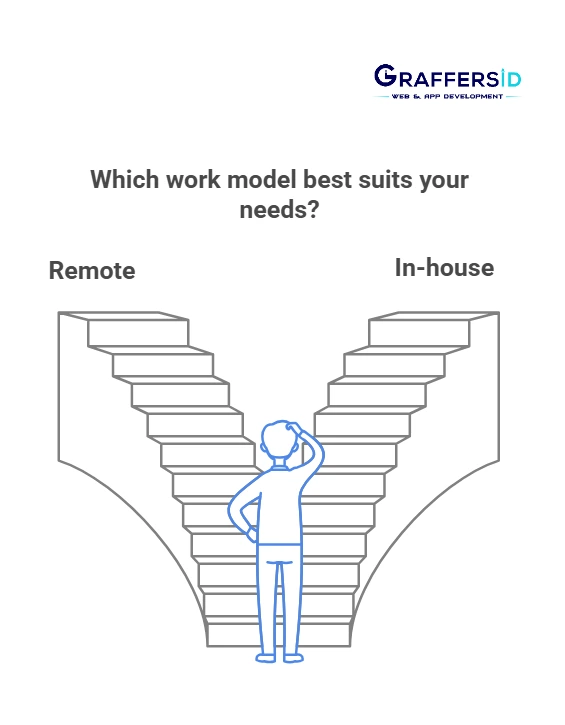Since the rise of remote work, there has been an ongoing debate between remote hiring and in-house hiring. However, in recent years, it has taken some fresh turns. Startups want to hire individuals specialized in their respective roles and are constantly looking for ways to scale efficiently. So it is important to understand the nuances of the two prevalent hiring models.
Benefits: Remote vs In-House

Benefits of Remote Hiring
Access to a Global Talent Pool
One of the biggest advantages of remote hiring is access to the expanded talent pool. The restriction of geographical boundaries will no more limit the scope of hiring, and you can source specialized skills from around the world. Early-stage startups are constantly competing for top-tier developers and AI engineers. If you opt for remote hiring, you can find the best person for the job regardless of location.
Cost-Effective Hiring
Remote hiring can help companies skip costs like office overheads. They can hire from regions where talent is cheaper yet as skilled as compared to their own region. This does not imply that they are underpaying the employees; rather, it implies that the pay scale can be altered according to the living costs of the hiring region.
Flexible Work Environment
Remote teams can work in different time zones, leading to a flexible schedule. Ultimately, this can boost productivity for certain individuals. They can also save on commute costs and time, which helps them build a better work-life balance. In a flexible work environment, developers feel more liberated and motivated to work, as there is no rigidity in the schedules.
Rapid Scalability
Startups can scale their teams quickly if they opt for remote hiring, as the new talent does not need to relocate to another location or face any logistical bottlenecks. Remote onboarding processes have really evolved in recent years, making it easier to integrate new employees smoothly.
Read More: AI Bots in Virtual Interviews: How to Detect & Prevent Interview Cheating
Benefits of an In-House Hiring
Enhanced Communication and Collaboration
Since your in-house team is situated in one place, it becomes easier to schedule quick brainstorming sessions, discuss complex problems and their solutions, and hold quick stand-up meetings. Face-to-face communication builds trust, understanding, and good alignment with goals. In-house teams also embrace office camaraderie and collaboration among teams.
Stronger Organizational Culture
With an in-house team, your company culture can be taught to the team easily when compared to remote teams. The formal and informal culture, be it office layouts or shared lunches and coffee breaks, in-house teams can build cohesive identities. For some companies, this is a very important factor and instills a sense of shared mission and innovation.
Easier Onboarding and Mentorship
When fresh talent is hired, they can shadow their seniors or peers or attend in-person training sessions to learn the day-to-day operations. This environment promotes knowledge transfers and supports one-on-one mentoring. Also, some employees find it easier to clear doubts and ask questions when they are in person and receive immediate feedback on their work.
Simplified Compliance and Security
Maintaining the security of data is easier to manage when everyone is in one place. All the laptops and devices are registered on a single network, access to all the resources can be controlled, and the IT service is more immediate. Additionally, companies that need to comply with regulatory frameworks (e.g., HIPAA, PCI-DSS) find it easier to maintain compliance with in-house teams.
Real-Time Collaboration for Rapid Prototyping
Tech companies usually work in an “all-hands-on-deck” mode. Refining features and staying ahead of the competition requires rapid iteration. When teams are in-house, they can meet and discuss new developments very quickly, and problems can be solved as soon as they arise.
Cost Comparisons: Remote Hiring vs. In-House Hiring
Office Space and Infrastructure
Remote Teams: Remote teams can significantly reduce or even eliminate the cost of office lease expenses, utility bills, and furniture costs, alongside other amenities. You will have to, however, invest in tools and software for the collaboration of the team. There are certain other overhead costs, like the home office setup.
In-House Teams: One of the biggest costs when running a company is the office rent. Tech companies need to invest a lot in their office setups when maintaining an in-house team. Other costs include non-materialistic perks like lunches, game rooms, or comfortable seating areas where teams can spend their breaks.
Salaries and Benefits
Remote Teams: Since the teams are remote, salaries are flexible based on geographic differentials in cost of living. However, since remote developers are in high demand, competition can drive up salaries. Benefit packages provided to the teams might also need to be molded according to the country’s health care and welfare systems.
In-House Teams: Salaries need to match the standard of living of the country, and if the cost of living is high, it can drive up the costs. However, there is the advantage of hiring from local talent pipelines.
Productivity and Team Management Tools
Remote Teams: Tools that assist in collaboration, like Slack, Microsoft Teams, Zoom, Jira, etc. of remote teams are essential subscriptions. Platforms for project management and communication, or virtual whiteboarding, are other tools that require investment. These tools might have costly subscriptions, but they reduce friction for distributed work.
In-House Teams: In-house teams might rely less on these tools. Since the meetings can happen in person, they might not need these tools otherwise.
Turnover and Retention
Remote Teams: Remote roles come with great flexibility, which can appeal to candidates, and if the compensation aligns with their standards, then they prefer to stay on. However, if the work culture and compensation do not align with their needs, they might leave quickly.
In-House Teams: To retain in-house employees, it is important to create an engaging environment that keeps employees motivated. They should be able to see a future with the company; otherwise, they might choose remote opportunities where they can build a better work-life balance.
Read Also: Strategies for Reatining Developers
Scalability Considerations for Startups

Speed to Scale
Remote Teams: When a company is in urgent need of employees, remote hiring can be faster. You need not wait for the candidate to relocate or set up their office space.
In-House Teams: When scaling in-house, there is a sufficient amount of beforehand planning that goes in, and if the candidate is from out of town, then you need to wait for them to relocate. On top of that, new hires integrate into existing cultures, which takes a little more time.
Process and Project Management
Remote Teams: For asynchronous communication between distributed teams, tools like Trello, Asana, or Jira can be utilized to centralize tracking of tasks and progress. Project managers need to be aware of the various time zones and navigate work accordingly.
In-House Teams: In-house teams can be managed more proactively and on an ad-hoc basis. Quick check-ins, direct feedback, and daily standups all make project monitoring easier. However, to manage a large in-house team, project managers must maintain efficiency and avoid chaos.
Company Culture and Team Morale During Growth
Remote Teams: A distinctive challenge in remote teams is maintaining a sense of belonging and instilling company culture. Companies must invest in virtual events, conduct frequent check-ins, and possibly arrange some on-site activities once or twice a year.
In-House Teams: It is easier to instill company culture in your in-house teams, but maintaining large teams or overcrowded workspaces dilutes the culture if new hires are not trained properly.
Conclusion
After looking at this extensive breakdown comparing remote hiring and in-house hiring, you can get a good idea of what you prefer. The needs and budget of every company differ, and based on the specific requirements, you should make a decision that will fit.
GraffersID is the ideal choice for remote development. If you choose to partner with us, you gain access to highly experienced developers. Our model minimizes office-related overheads while fostering quicker onboarding and scalability. We place strong emphasis on seamless collaboration and team integration, supporting you with robust remote work tools and best practices to keep everyone aligned with your objectives. Furthermore, our attention to cultural fit and communication ensures that remote developers remain just as invested in your mission as an in-house team would be, helping you retain the talent you need for steady, long-term growth. Contact us today!






